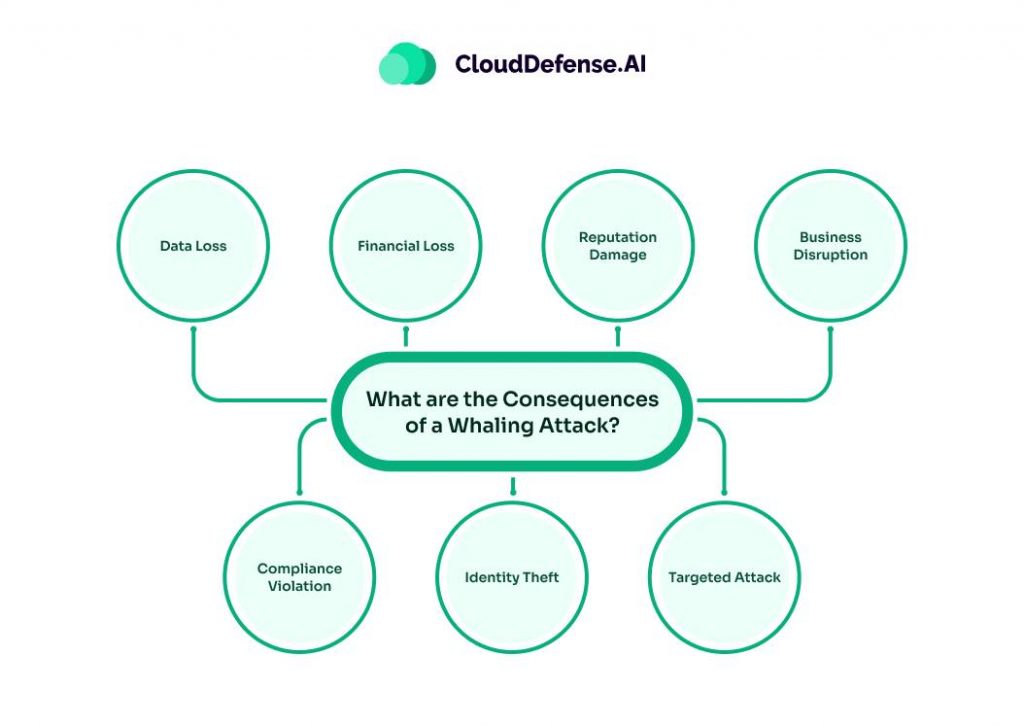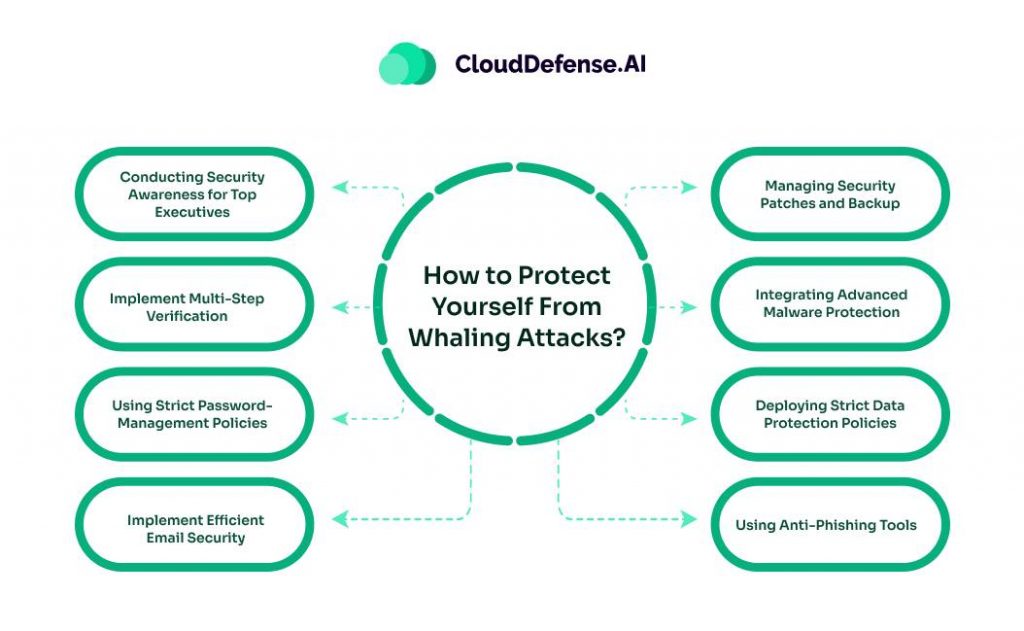What is Whale Phishing?
A whale phishing also known as a whale attack is a highly sophisticated attack that is mostly targeted toward top executives of organizations. Whether it is CEO, CTO, CFO, or any managing partner, an attacker sends phishing emails disguised under known email.
Every year many top-tier executives fall victim to this attack. A report by Security Magazine states that whaling attacks are estimated to cost $1.8 billion and executives face this attack every 24 days. Whale phishing is carefully designed to deceive top executives who have access to sensitive financial data and important areas of a network. In general, a whale attack is executed over a long time which is usually a month.
The attacker pretends to be a trusted email and interacts with the target for a long time to establish trust. Rather than quickly fetching them a phishing email that can raise suspicion, the attacker takes time to make the final move.
Once the attacker slowly gains trust and proves to the top executive who they claim to be, the attacker can easily extract the sensitive data. The attacker makes use of various social engineering techniques to manipulate the victims into giving away the needed details.
The term whaling is indicated due to the sheer vast size of the attack. The term “whale” is used for top authorities who have deep access to the system.
How do Whaling Attacks Work?
A whaling attack is an advanced phishing attack that begins by the attacker impersonating a trusted source and communicating with the victim. The victims are mostly the CEO or top executive of the target organization who can give access to the network or fetch various financial details.
The attackers craft the email in such a way that it looks like it originated from a trusted source, partnering vendor, or HR representative. Usually, the communication happens through email or sometimes texts using specific details that the attacker has collected through various techniques or social media.
Since the attacker sends emails with specific details and meticulously crafts the email, there is no reason the target will speculate the identity of the attacker.
In most cases, the email addresses are faked or the attacker uses the same username as a known associate of the organization. The attacker might also hijack the account of a known partner that the top executive can trust.
Once the trust has been gained, the attacker then tries to manipulate the top executive to provide the necessary sensitive information.
The information may range from financial details, employee payrolls, and credentials to private networks to authorizing a hefty wire transfer. If the executives are not well aware then may provide many other important details that might help the attacker to carry out a complete breach.
Identifying a whaling attack is quite tricky because they don’t carry the usual signs of a phishing attack. As the attacker utilizes intriguing details and social engineers, it becomes hard to detect a whaling attack. The attacks are so nuanced that they bypasses traditional email security and anti-phishing monitoring tools.
What is the Goal of a Whaling Attack?
Attackers unleash whaling attacks on top executives of organizations to deceive them by providing various information that will benefit the attacker in different ways. Here are some reasons that lead attackers to launch whaling attacks:
Money: One of the primary reasons behind launching whaling attacks is to extract a huge amount of money. Usually, the attacker uses spear phishing techniques to trick the victim into sending a large sum of money through a wire transfer. After manipulating a CEO into giving away sensitive data, the attacker might also use extortion techniques to grab money.
Control Over System: Through whaling attacks, cybercriminals get their hands on vital credentials of an organization’s network.
This allows them to move laterally in important parts of the network and open the backdoor for other attacks. Sometimes, attackers manipulate the victim into giving them administrative access to a network that helps them carry out their illicit tasks.
Attack on Supply Chain: On various occasions, attackers carry out whaling attacks to disrupt an organization’s supply chain. Once an attacker gains access to the weak point, it can disrupt the supply chain of any organization.
Corporate Espionage: Rival organizations or countries often fund attackers to carry out whaling attacks to steal trade secrets or other sensitive details. Corporate espionage is a common goal for many state-funded cybercriminal groups.
Malware Distribution: Malware distribution serves as a common goal behind a whaling attack. Through this attack, the cybercriminals are able to open backdoor for further attacks like ransomware and rootkits. Sometimes, the attacker tricks a board member into installing malware.
Personal Vengeance: In certain scenarios, whaling attacks are carried out on specific executives of an organization out of vengeance. It could be a rival organization or someone else as a whaling attack severely damages the reputation.
Who is Vulnerable to Whaling Attack?
Whaling attacks are designed by cyber criminals to target top-ranking personnel of an organization. Since CEOs, CFOs, and CTOs have access to sensitive information and have decision-making power, they are widely targeted for whaling attacks.
Senior administrators and managers who have access to different organization’s data including financial are also vulnerable to whaling attacks. Every high-profile personnel of an organization is always vulnerable to cyber criminals who look for ways to attack them.
Besides top executives of an organization, cybercriminals also target HR personnel of the organization. HR managers hold access to all the sensitive employee details. Cybercriminals with the intent to steal them often make use of whaling attacks in manipulating the personnel into giving away the information.
Cybercriminals often launch whaling attacks on high-ranking employees in financial and IT departments due to complete access to network and data storage.
Manipulating these employees to install rootkits or any malware can offer cybercriminals unrivaled access to many intrinsic details. Business partners and board members who hold significant authority widely face whaling attacks during their tenure.
Whaling attacks are quite difficult to detect and they are so subtle that it easily bypasses standard security measures. Whaling attacks are increasing throughout the world and with new techniques, cybercriminals are getting more sophisticated with their process.
Since 2015, the US industry has seen a significant rise in whaling attacks. According to global data, the average cost of data breaches has reached $4.91 million in 2022. However, with proper security measures and awareness programs, organizations can significantly reduce the chance of whaling attacks.
What are the Consequences of a Whaling Attack?

If a threat actor successfully pulls a whaling attack, it can harm the organization in many ways. The consequence of a whaling attack depends upon the motive of the cybercriminal. Here are some major impacts of the attack:
Data Loss
A major consequence of a whaling attack is the loss of sensitive data and intellectual property of an organization. Such attacks also lead to loss of trade secrets which can severely damage the organization.
Financial Loss
A successful whaling attack also causes organizations to face many financial losses. The attacker may wire transfer funds or steal many assets which would lead to huge loss. Moreover, the cost of recovery and reinstalling the measures can also cause a major financial setback.
Reputation Damage
Usually, cybercriminals through whaling attacks steal all the customer data and financial details. Such news of attack can severely damage the reputation and trust of the organization in the industry and among its users.
Business Disruption
Whaling attacks can cause massive disruption in the business workflow, leading to low productivity and high downtime. The affected organization will have to divert all the resources to respond to the security incident and face a loss of opportunities.
Compliance Violation
Loss of data, especially customer information, can lead to compliance violations and non-adherence to privacy regulations. As a result, the victim organization will have to pay hefty legal fines and penalties for non-compliance.
Identity Theft
Another major consequence of a whaling attack is identity theft where the attacker utilizes the identity of the top executives to carry out more malicious activities. The attacker may assume the identity of the CFO to carry out fraudulent money transfers, apply for loans, or perform further phishing attacks.
Targeted Attack
A whaling attack can open a gateway for cybercriminal groups to carry out further advanced attacks. Once the attackers get their hands on high-profile accounts and financial details, they can use them to launch further attacks on the organization.
How to Protect Yourself From Whaling Attacks?

When it comes to defending your organization from whaling attacks, there are many ways that can help you prevent such attacks. Here are some effective measures that you can implement:
Conducting Security Awareness for Top Executives
Top executives, senior employees, and your organization’s finance teams are highly vulnerable to whaling attacks. So it is important for every organization to conduct awareness programs so that they can learn about whaling attacks and how they can detect them.
Everyone should know about social engineering tactics and how they can prevent such attacks. Employees should be trained to assess the domain name and communicate in other channels before accepting a request.
Implement Multi-Step Verification
To prevent whaling attacks, an organization must implement a multi-step verification process like multi-factor authentication.
It ensures users have to go through two or more verification processes before granting access. Thus when a user initiates a wire transfer or tries to access confidential data, they will have to go through a series of identification requirements.
Using Strict Password-Management Policies
Maintaining a stringent password-management policy can help in curbing whaling attacks. It will not only prevent email compromises but also various whaling tactics that exploit the credentials of user accounts.
For strict password management, all the passwords should be changed at regular intervals and they should be made in a complex format. Security questions should be introduced for every login process.
Implement Efficient Email Security
Emails are widely exploited in whaling attacks as most of the process is done through email spoofing.
Implementing efficient email security that involves appropriate SPF, DMARC, and DKIM settings can help in curbing email exploitation. Proper email security will help in flagging external emails with suspicious origin.
Managing Security Patches and Backup
It is important that all the security patches should be managed efficiently because it will prevent the application from getting exploited.
Frequent security patch updates will remediate the vulnerabilities and prevent any targeted phishing attacks. Backups will help in storing the sensitive data in protective storage and help during the recovery process.
Integrating Advanced Malware Protection
Another efficient way to curb whaling attacks is by employing advanced malware protection (AMP). Integrating AMP into your existing email protection suite will eliminate all the malware that is enforced through whale phishing. AMP is able to minimize the impact of advanced malware and damage from breaches or infection.
Deploying Strict Data Protection Policies
Organizations can deploy data protection policies that will constantly monitor data storage and emails for malicious activity.
It will constantly look for indicators of compromise and if it suspects any phishing attack, then it will block the email or user accessing data storage. The protection policies play a significant role in preventing whale phishing and other phishing attempts.
Using Anti-Phishing Tools
Introducing anti-phishing tools in the existing security strategy will be highly useful in preventing whaling attacks. The anti-phishing tools can not only minimize the impact of whaling attacks but also ransomware and other phishing attacks. It might not be able to prevent different anti-phishing tactics but it can prevent malicious activities associated with it.
What are the Differences Between Phishing, Spear Phishing, and Whaling Attack?
Phishing, whaling attacks, and speaker phishing are dangerous cyberattacks that may serve as a form of phishing attack. However, they are quite different from each other in the scope, methodology, and target.
Phishing serves as a broad term that is used for tricking victims into falling into a trap and making them reveal personal data or downloading malicious software. On many occasions, victims are tricked into completing fraudulent transactions.
The attackers often use various fake websites disguised as legitimate ones and compel victims into making payments or providing personal details. Usually, bank accounts or any financial services are put up as bait and victims are manipulated into providing login credentials.
Spear phishing is a segment of phishing attacks where the attacker mainly focuses on a specific individual. Some attackers often use spear phishing to target an important individual in a particular office or department.
In spear phishing, the attacker often uses personalized emails or messages to deceive receivers into thinking it is a legitimate message. The specific individual might be targeted by messaging that the individual’s ATM card has been skimmed. The individual must click on the link to login and change the password.
A whaling attack is a specific form of spear phishing where the group of attackers mainly targets a high-profile or important individual of an organization. Here the attacker doesn’t utilize traditional phishing methodology, rather they impersonate as a partner or associate of the victim.
The whole process takes over a month as the attacker has to build trust before making the final move. The attackers are highly crafted so that they can deceive the victim into providing critical business information.
Final Word
A whaling attack is a highly specialized phishing attack that is often carried out by a group of attackers to extract financial details or organization’s sensitive data. However, staying aware and taking certain preventive measures can minimize the exposure to whaling attacks.
Through this guide, we have highlighted all the details you need to know about the whaling attack and how to prevent it. We have also put forward many other details that will help executives in minimizing the exposure to such attacks.







